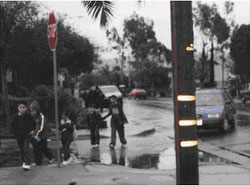Pedestrian Safety Education in a San Diego County School
San Diego, California
Source: Pedestrian and Bicycle Information Center (PBIC)

One of the images used in program to depict bad pedestrian behavior.
Problem
There was need for greater pedestrian safety training targeted specifically for English as a second language (ESL) students and recent immigrants, as studies showed that first-generation low income school children are at a much higher risk of pedestrian injuries and fatalities (Sarkar, 3).
Background
Developers of a child pedestrian safety training program in San Diego County targeted a bilingual low-income school where the majority of the children walked to school.
Solution
The presentations were bilingual and used still images and video footage from their own neighborhood to make the lessons more relevant and concrete. Students were asked to identify the unsafe behaviors depicted and to suggest safer alternatives. For example, they were shown an image of children in dark clothing walking across an intersection a car had already begun to turn into. Were the children very visible to the car? Should the children have walked into the street then?
Other topics covered included stopping distances of vehicles in the rain, at different speeds, and for large trucks; mid-block crossings; facing traffic while walking; running; turning vehicles; and more.
Results
In a survey conducted two weeks later, the children largely retained the information presented earlier. However, a large minority of students responded that either their parents, the Safety Patrol, or their siblings were responsible for their safety, and that "Cars will always stop for kids." Thus, it was determined that there was a need to better emphasize to the children that they were the ones responsible for their own safety in future training materials.
Sarkar, S., Andreas, M. et al. Effectiveness of a Low Cost Video-based Training Program to Reduce Child Pedestrians injuries in Low-Income Neighborhoods. Call for Papers TRB Committee on Environmental Justice (ADD50). pp. 1-20.
Contact
Sheila Sarkar, Professor
UC-San Diego
shsarkar@ucsd.edu
Images Source
Sheila Sarkar.




